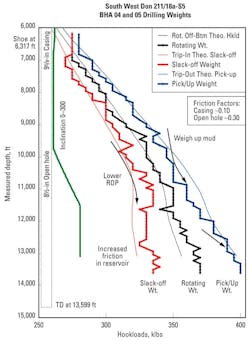Maximizing drilling performance makes marginal fields pay
Gerrard Ipenburg
Charles Taylor
Mohammad Pajouhesh
Dirk De Clercq
Neil Meldrum
EnQuest
Ruairidh MacLure
Scott Mabon
Sandy Dunn
Tom Reeve
Tim Blasdale
Schlumberger
Squeezing profit out of smaller, less economic reservoirs requires getting the most out of today's available tools to ensure that wells are delivered on budget and on time.
Achieving this profit goal requires best practices and new techniques to push the limits of drilling performance. A combination of tight teamwork, new technology, and the application of innovative practices have proved their value in a North Sea field previously considered uneconomic.
The Don area comprises several small oilfields approximately 145 mi (230 km) northeast of the Shetland Islands in the UK sector of the Northern North Sea. The reservoirs were discovered in 1975 and first oil was produced in 1989. In 2005, the then owners of the field ceased production and began preparations for the facilities to be decommissioned.
The submission in the Decommissioning Program stated "The Don field has reached the end of its economic life." However, instead of decommissioning, the interests were sold to Petrofac Energy Developments Ltd (PEDL), a mother-company of the current license holders, EnQuest, an independent oil and gas company focused on the development and production of discovered reserves, late life assets, and near field appraisal and exploration on the UK continental shelf (UKCS). The company has stated aims to "expand through the drill bit," leveraging the opportunities provided by modern directional drilling technologies.
In 2007, a new field development program (FDP) was submitted for the West Don field, which was to be jointly developed, along with the Don Southwest field, using high-angle producer wells. Regulatory approval was granted the following year and drilling began in late July, 2008. Production from the West Don field resumed on April 28, 2009. In the first four months of 2011, the Don fields produced an average of over 15,000 boe/d and Don Southwest recently delivered its 10 millionth barrel of oil.
Back onstream
Keeping the Don development economic would require a low cost-base and assured well delivery. EnQuest contracted theJohn Shaw semisubmersible, built in 1982, and selected Schlumberger for the required directional drilling services. An integrated project team was quickly assembled that included experts from the operator, rig contractor, Schlumberger, and other service companies. M-I SWACO, a Schlumberger company, provided the drilling mud and ship-and-skip operations. All team members were encouraged to take ownership of the performance of the project as a whole, and between them identified ways to optimize the development, which included three innovative approaches:
• The drilling program was planned to allow batch setting of wells from top hole to total depth on proximal wells. This enabled the reuse of BHAs and other equipment to complete the drilling of each hole size for wells close enough to be skidded between before changing the BHA to start drilling the next hole size.
• As many as possible of the BHA components – including bits – were torqued-up onshore and the BHA design was evolved to optimize handling. The pre-made BHAs saved time and reduced exposure to the hazards of moving heavy items on moving rigs.
• Exploratory side tracks were drilled from production wells prior to the reservoir section and then plugged back, saving the need to drill dedicated surface sections for these wells.
Initial progress exceeded expectation. First oil was produced less than one year from receiving FDP approval. Phase I of the drilling program was completed in July 2009, when well S4 reached total depth. This was the seventh development well drilled in a year, plus an additional three exploratory sidetracks.
Taking stock
Phase II of the drilling program followed a period of shipyard work when new cranes and cuttings handling equipment were installed. The same Don development team was retained to capitalize on knowledge gained during the first phase of drilling activity. EnQuest used the break in drilling to provide the opportunity for team members to challenge limits and recommend more, and better, solutions to build on the good initial performance. Procedural changes introduced early in 2010 included:
• A reduced casing strategy, replacing the previously used 5-section well with a 4-section well, with the final reservoir section being drilled from a higher stratigraphic location. This required close control on mud weight for well bore stability, and on equivalent circulating density (ECD) for fracture gradient and differential sticking. The new approach created a long open-hole section through the reservoir, and so required a long liner run.
• BHA designs were adjusted to carry the bulk of the BHA through the top three sections, reducing time, risk, and logistical needs in BHA handling.
Drilling procedures were fine-tuned, developing practices specific to each section to mitigate local risks. For example, the designed trajectory and connection procedures through weaker formations were adjusted to minimize exposure to stuck pipe, and extra care was taken to avoid stressing these weaker sections.
The main limiter to increasing penetration rates was perceived to be hole cleaning – related both to clearing of the annulus and cuttings handling at surface. Improved surface cuttings handling was addressed by the shipyard work and the perception of poor annular clearing was analyzed by monitoring of hole cleaning through tracking of torque, drag, and ECD trends. The analyses indicated that ROP performance could be improved, pushing the elderly rig beyond its previously expected capabilities while closely monitoring the drilling parameters.
Moving up a gear
A step-change in rate of penetration (ROP) was achieved in Phase II of the drilling program, with improvements seen in all sections. Close monitoring of downhole conditions enabled significant ROP increases, and opportunities for further incremental changes were constantly reviewed. The main remaining obstacle to improved performance was high to severe stick-slip, seen only on bottom, particularly with PDC bits in the reservoir section. Analysis of the problem indicated it was related to the heave compensator, as stick-slip was low in good weather and on nearby semis with newer compensators.
A pragmatic approach was taken, in which it was considered that the simplest remedy was to deal with the stick slip through BHA and well design, accommodating the inherent problems as best as possible. To this end drill bits were selected that had the maximum wear resistance at the shoulder – the area most prone to damage from stick slip.
The point-the-bit PowerDrive Xceed RSS tool was deployed. Designed for extreme conditions, this tool can cope with up to 350 rpm stick slip, and drilling was pushed-on to limit the time exposed to the shock. The drilling tools proved to be highly robust. Despite being regularly exposed to severe stick-slip in excess of 150-200% of surface rpm, during the three years to the date of writing this article, there were only three trips for any downhole tool failure, including the measurement-while-drilling (MWD) and logging-while-drilling (LWD) tools; and one of these trips was due to a washout.
Cost savings
One of the more recent wells drilled from theJohn Shaw was designed as an extended reach drilling (ERD) well to tap the previously undeveloped Don Southwest reservoir. Well S7 was a challenging step-out that would stretch the rig's capabilities, but would save more than $30 million in hardware alone compared to having to perform a subsea tieback from a closed surface location. The BHA included advanced multifunction LWD, formation pressure-while-drilling, and high-speed telemetry tools, delivering high-quality measurements in a well that could be challenging to log later using wireline.
DLS was controlled throughout the build from 18º to a 67º tangent, resulting in low friction factors (<0.1 OH FF) seen for torque. The S7 well was successfully drilled with a 12,505-ft (3,812 m) long 8½-in. section drilled in two runs, the first run of 11,650 ft (3,551 m) being a North Sea record before pulling out to change the bit. It was drilled in 95 hours with an average on-bottom ROP of 122 ft/hr. The success of S7 has enabled ERD targets to be planned in the future.
Benefitting the bottom line
EnQuest is justifiably proud of the performance of the drilling team. A combination of integrated planning and effective execution has enabled the field to be economically developed in the early twenty-first century using a rig designed for the challenges of the 1980s. The record drilling times achieved in 2010 were delivered by teams that have been working together – often on the same rig – on a steady flow of successive projects. Wells previously expected to require about 70 days were finished in just 35 days. Performance was maximized through joint development of appropriate procedures and the use of highly reliable tools, enabling confidence in extending operational targets and opening future development possibilities. The success of the approach is testified by a comment in the EnQuest plc 2010 annual report, which stated that: "faster than expected delivery of the wells drilled on the Dons was a key feature of the 2010 performance."
Offshore Articles Archives
View Oil and Gas Articles on PennEnergy.com


